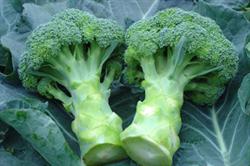What causes the hollow of the main stem of broccoli?

What causes the hollowing of broccoli stems? Broccoli stem hollow, but not rotten, is due to physiological disorders and the formation of. If the selection of varieties and planting management is not appropriate, resulting in plant physiological disorders, so that hollow will form, seriously affecting the quality of commodity bulbs and commodity value, resulting in losses. 1. The occurrence of hollow symptoms of the main stem is mainly formed during the mature period of the flower bulb. At first, several small elliptical gaps were formed in the stem tissue. As the plant grew and matured, the small gaps gradually expanded and connected into a large gap, which formed a hollow in the stem. When the hollow was serious, it extended to the flower stem. The cavity surface lignifies and turns brown, but does not decay, and no pathogen is detected from the discolored tissue. Second, the main stem hollow causes 1, planting plant spacing is too large, excessive nitrogen fertilizer, especially in the flower bulb growth period, plant growth too fast, easy to cause hollow occurrence. 2. Lack of water or improper watering during vegetative growth period and flower bulb growth period is easy to cause the occurrence of empty stems. 3, broccoli is a cool crop, the appropriate growth temperature is 15~ 22℃, such as improper planting season arrangement, in the flower ball growth period in case of high temperature ( 25℃ above), so that the flower ball grows too fast, easy to cause hollow. 4. Boron deficiency can induce the change of cell wall structure in stem tissue, which leads to the degeneration of stem tissue and the formation of hollow with lignification. 5. Different varieties have certain differences in susceptibility to hollow, some varieties have wide adaptability, not easy to hollow, and some varieties are easy to hollow. 3. Control measures 1. Choose varieties that are not easy to hollow. 2. Timely sowing, cultivation of strong seedlings, timely planting, staggered flower bulb growth period encountered high temperature weather. 3, according to the characteristics of the varieties used, reasonable density planting. The suitable plant spacing is 30~45 cm and row spacing is 60~70 cm. 4. Fertilizer and water management. Water management: keep the soil dry and wet, generally require watering every 5 to 7 days. Fertilizer management: under the condition of applying sufficient base fertilizer, nitrogen fertilizer can be applied 6-8 kg per mu with watering, and the principle of small amount and multiple times is to increase the application amount of phosphorus and potassium fertilizer during the flower bulb growth period. For boron deficient soil, 0. 5 kg boron fertilizer as base fertilizer, then 0. 5 kg for topdressing or root irrigation. 5. Timely harvest. It can be harvested within 10 - 15 days from the flower ball. Early bulbs do not fully grow, low yield, too late easy to form empty stems, and flower bulbs easy to loose, withered buds, lose its commercial value. Click for more cauliflower growing techniques Click for more vegetable growing techniques
- Prev

What causes the quality deterioration of summer cauliflower?
What causes the deterioration of summer cauliflower quality? Please introduce the quality of cauliflower in summer production, often due to the influence of environmental conditions and improper cultivation measures. In many years of planting cauliflower, we have accumulated some experience in preventing the deterioration of common cauliflower quality, which is now introduced to you for reference. ...
- Next

How can broccoli be planted with high yield?
How can broccoli be planted with high yield? Please introduce the cultivation of broccoli to obtain high yield can refer to the following planting methods: first, variety selection in the selection of early-maturing, high-quality varieties. Second, sowing time and method (1) sowing time sowing in early January in greenhouse. (2) the mode of sowing.
Related
- Where is it suitable to grow horseradish in China? it is expected to see the middle altitude horseradish in Alishan.
- How to prevent tomato virus disease reasonably? (Control methods included)
- Many people like to plant towel gourd on the balcony. What are the main points of this method and management?
- What crops can chili peppers be mixed with?
- Fertilization techniques and matters needing attention in Tomato
- What are the grafting techniques for peach seedlings in spring?
- Harm and control methods of root swelling disease of Chinese cabbage
- What are the pests of sweet potatoes? How to prevent and cure it?
- Symptoms, causes and Control methods of navel Rot in Tomato
- The cause of "Cucumber rotten bibcock" in Farmers' planting Cucumber and its Control Plan

